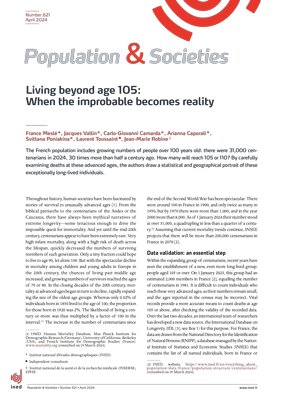Living past age 105: When the improbable becomes reality
Press release Published on 24 April 2024

There are 31,000 centenarians in France in 2024, 30 times more than half a century ago. How many will reach age 105 or 110? Why are almost all supercentenarians women? And why are there so many on the French Caribbean islands of Guadeloupe and Martinique? The authors draw a statistical and geographical portrait of these exceptionally long-lived people.
Until the mid-20th century, centenarians appear to have been extremely rare. Very high infant mortality, along with a high risk of death across the lifespan, quickly decreased the numbers of surviving members of each generation. Only a tiny fraction could hope to live to age 90, let alone 100. However, with the remarkable mortality decline among children and young adults across Europe in the 20th century, then at advanced ages in the last decades of the century, the size of the oldest age groups has expanded rapidly. Whereas only 0.02% of individuals born in 1850 lived to age 100, the proportion for those born in 1920 was 2%. The likelihood of living a century or more was thus multiplied by a factor of 100 in the interval. The increase in the number of centenarians since the end of the Second World War has been spectacular. From above 1,000 in France in 1970, their number grew to over 8,000 in 2000, and over 31,000 on 1 January 2024. Assuming that current mortality trends continue, INSEE projects that there will be more than 200,000 centenarians in France in 2070.
Growing numbers of deaths beyond age 105… most of them women
Within the expanding group of centenarians, recent years have seen the establishment of a new, even more long-lived group of people aged 105 or over. While representing a minute fraction of the over 600,000 deaths recorded annually in France (under 0.15%), their number has surged in recent years, rising from just a handful of individuals in the late 1980s to 924 in 2020. The vital records of these deceased individuals were verified by the authors, to guarantee the validity of these figures and avoid any errors.
The vast majority of people who die at age 105 or above are women (843 women and 81 men in 2020, or 10 times more women). This impressive ratio is entirely due to excess male mortality, which operates throughout the lifespan, particularly at working ages, and which correspondingly decreases the size of male cohorts in comparison to their female counterparts.
The profile of supercentenarians
People who reach their 110th birthday are known as ‘supercentenarians’. While living beyond this age is still a rare event, it has become much more frequent in recent decades. In 2022, 39 people died at age 110 or above, of whom the overwhelming majority38 out of 39were women.
At the department level in metropolitan France, the ratio of deceased supercentenarians to the total population ranges from 0 to 17 per million inhabitants, but with no clear geographical pattern. The overseas departments of Guadeloupe and Martinique, with 44 and 36 supercentenarians per million inhabitants, respectively, stand out clearly from the rest of France, however. Proportionally, there are nearly eight times more supercentenarians in Guadeloupe and Martinique than in metropolitan France.
Authors: France Meslé (Ined), Jacques Vallin (Ined), Carlo-Giovanni Camarda (Ined), Arianna Caporali (Ined), Svitlana Poniakina (Ined), Laurent Toussaint, Jean-Marie Robine (Inserm et Ephe)








